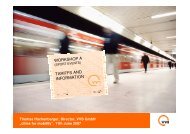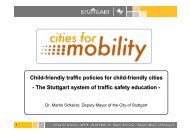Walking the social space Daniel Sauter, Urban ... - Cities for Mobility
Walking the social space Daniel Sauter, Urban ... - Cities for Mobility
Walking the social space Daniel Sauter, Urban ... - Cities for Mobility
Create successful ePaper yourself
Turn your PDF publications into a flip-book with our unique Google optimized e-Paper software.
<strong>Walking</strong> <strong>the</strong> <strong>social</strong> <strong>space</strong><br />
<strong>Daniel</strong> <strong>Sauter</strong>, <strong>Urban</strong> <strong>Mobility</strong> Research, Switzerland<br />
5th World Congress of <strong>the</strong> global network <strong>Cities</strong> <strong>for</strong> <strong>Mobility</strong><br />
City of Stuttgart, Germany, 3-5 July 2011<br />
<strong>Daniel</strong> <strong>Sauter</strong>, <strong>Urban</strong> <strong>Mobility</strong> Research, Switzerland
Do we experience <strong>the</strong> world differently<br />
when we walk compared to …<br />
If so, how is it different?<br />
… let’s say drive?<br />
<strong>Daniel</strong> <strong>Sauter</strong>, <strong>Urban</strong> <strong>Mobility</strong> Research, Switzerland
William (7) walks to school…<br />
Source: Marco Huettenmoser, Muri AG; www.kindundumwelt.ch<br />
<strong>Daniel</strong> <strong>Sauter</strong>, <strong>Urban</strong> <strong>Mobility</strong> Research, Switzerland
Sandra (7) is being driven to school …<br />
Source: Marco Huettenmoser, Muri AG; www.kindundumwelt.ch<br />
<strong>Daniel</strong> <strong>Sauter</strong>, <strong>Urban</strong> <strong>Mobility</strong> Research, Switzerland
Samuel (7) is being driven to school …<br />
Source: Marco Huettenmoser, Muri AG; www.kindundumwelt.ch<br />
<strong>Daniel</strong> <strong>Sauter</strong>, <strong>Urban</strong> <strong>Mobility</strong> Research, Switzerland
Maria (10) walks to school …<br />
Source: Marco Huettenmoser, Muri AG; www.kindundumwelt.ch<br />
<strong>Daniel</strong> <strong>Sauter</strong>, <strong>Urban</strong> <strong>Mobility</strong> Research, Switzerland
When and how do people enjoy <strong>the</strong> city?<br />
What are <strong>the</strong> characteristics?<br />
<strong>Daniel</strong> <strong>Sauter</strong>, <strong>Urban</strong> <strong>Mobility</strong> Research, Switzerland
<strong>Daniel</strong> <strong>Sauter</strong>, <strong>Urban</strong> <strong>Mobility</strong> Research, Switzerland
<strong>Daniel</strong> <strong>Sauter</strong>, <strong>Urban</strong> <strong>Mobility</strong> Research, Switzerland
“<strong>Cities</strong> have <strong>the</strong> capability of<br />
providing something <strong>for</strong><br />
everybody, only because, and<br />
only when, <strong>the</strong>y are created <strong>for</strong><br />
everybody.”<br />
Jane Jacobs<br />
<strong>Daniel</strong> <strong>Sauter</strong>, <strong>Urban</strong> <strong>Mobility</strong> Research, Switzerland
What does it take to build<br />
liveable streets…<br />
…to invite people to walk<br />
and stay in <strong>the</strong> city?<br />
<strong>Daniel</strong> <strong>Sauter</strong>, <strong>Urban</strong> <strong>Mobility</strong> Research, Switzerland
1) Provide <strong>for</strong> link & place<br />
• Spaces to walk<br />
Network of closely connected, unobstructed, high quality footpaths<br />
- <strong>for</strong> movements from A to B<br />
• Spaces to sit, stand and meet<br />
Streets and squares full of places to stay and sojourn<br />
- with <strong>for</strong>mal & in<strong>for</strong>mal seating options, street cafés et cetera<br />
- with views to see and be seen, with shade/sun, wind protection<br />
• Places to play and be active<br />
Provisions <strong>for</strong> children and adults<br />
- <strong>for</strong> different kinds of activities<br />
- water & trees; creative elements<br />
<strong>Daniel</strong> <strong>Sauter</strong>, <strong>Urban</strong> <strong>Mobility</strong> Research, Switzerland
Sociability requires <strong>space</strong>…<br />
<strong>Daniel</strong> <strong>Sauter</strong>, <strong>Urban</strong> <strong>Mobility</strong> Research, Switzerland
Times Square New York<br />
<strong>Daniel</strong> <strong>Sauter</strong>, <strong>Urban</strong> <strong>Mobility</strong> Research, Switzerland
How we treat public <strong>space</strong>s<br />
and <strong>the</strong> users today…<br />
considered normal… considered an offence…<br />
Source: www.permanentbreakfast.org<br />
<strong>Daniel</strong> <strong>Sauter</strong>, <strong>Urban</strong> <strong>Mobility</strong> Research, Switzerland
2) Reduce speeds and volumes of motor-traffic<br />
Neighbourhood contacts in street with heavy traffic: 16.000 vehicles per day<br />
0.9 friends per person; 3.1 acquaintances<br />
Source: Donald Appleyard: „Livable Streets“, 1981<br />
<strong>Daniel</strong> <strong>Sauter</strong>, <strong>Urban</strong> <strong>Mobility</strong> Research, Switzerland
Neighbourhood contacts<br />
Street with moderate traffic: 8.000 vehicles per day<br />
1.3 friends per person; 4.1 acquaintances<br />
Source: Donald Appleyard: „Livable Streets“, 1981<br />
<strong>Daniel</strong> <strong>Sauter</strong>, <strong>Urban</strong> <strong>Mobility</strong> Research, Switzerland
Neighbourhood contacts<br />
Street with light traffic: 2.000 vehicles per day<br />
3.0 friends per person; 6.3 acquaintances<br />
Source: Donald Appleyard: „Livable Streets“, 1981<br />
<strong>Daniel</strong> <strong>Sauter</strong>, <strong>Urban</strong> <strong>Mobility</strong> Research, Switzerland
90%<br />
80%<br />
70%<br />
60%<br />
50%<br />
40%<br />
30%<br />
20%<br />
10%<br />
0%<br />
Low speeds support neighbourhood contacts, street life,<br />
safety, security, feeling of belonging and happiness<br />
15%<br />
12%<br />
50 km/hr street<br />
30 km/hr street<br />
20 km/hr street<br />
33%<br />
Neighbours on<br />
opposite side<br />
15%<br />
49%<br />
76%<br />
Feeling quite<br />
or very safe<br />
45%<br />
56%<br />
75%<br />
Feeling at<br />
home here<br />
Source: Research project „Liveable Streets and Social Inclusion“ by <strong>Daniel</strong> <strong>Sauter</strong> & Marco Huettenmoser;<br />
commissioned by Swiss National Science Foundation; see „<strong>Urban</strong> Design International“ 13/2 (2008)<br />
24%<br />
37%<br />
51%<br />
Sojourning<br />
in street<br />
65%<br />
61%<br />
87%<br />
Help in<br />
emergency<br />
28%<br />
31%<br />
58%<br />
Participation<br />
in decisions<br />
<strong>Daniel</strong> <strong>Sauter</strong>, <strong>Urban</strong> <strong>Mobility</strong> Research, Switzerland
3) Recognise walking as<br />
inherent expression<br />
of being human<br />
Alberto Giacometti<br />
L‘Homme qui marche II, 1960<br />
Photo: Sabine Weiss<br />
<strong>Daniel</strong> <strong>Sauter</strong>, <strong>Urban</strong> <strong>Mobility</strong> Research, Switzerland
Allow people …<br />
… to move according to <strong>the</strong>ir needs<br />
… in an environment built to human scale<br />
… to be treated with dignity and respect<br />
<strong>Daniel</strong> <strong>Sauter</strong>, <strong>Urban</strong> <strong>Mobility</strong> Research, Switzerland
No more subjection to <strong>the</strong> car logic: (re-)instating dignity<br />
Sources: St. Galler Verkehrsbüchlein 1930 (Haettenschwiler 1990), BfU 1997<br />
Chur 1939 Interlaken 1953<br />
<strong>Daniel</strong> <strong>Sauter</strong>, <strong>Urban</strong> <strong>Mobility</strong> Research, Switzerland
No more turning advantages of walking into disadvantages<br />
<strong>Daniel</strong> <strong>Sauter</strong>, <strong>Urban</strong> <strong>Mobility</strong> Research, Switzerland
An environment made <strong>for</strong> people<br />
• Keep <strong>the</strong> distances short<br />
- Land use & good access to public transport<br />
• Start with needs of walkers and sojourners<br />
- Plan & design with characteristics of walkers in mind<br />
• Build places to human scale<br />
- Small things important: façade structures, details (5km/hr view)<br />
<strong>Daniel</strong> <strong>Sauter</strong>, <strong>Urban</strong> <strong>Mobility</strong> Research, Switzerland
<strong>Daniel</strong> <strong>Sauter</strong>, <strong>Urban</strong> <strong>Mobility</strong> Research, Switzerland
Creating a walkable city…<br />
…what does it cost?<br />
… can we af<strong>for</strong>d it?<br />
<strong>Daniel</strong> <strong>Sauter</strong>, <strong>Urban</strong> <strong>Mobility</strong> Research, Switzerland
Getting <strong>the</strong> budget priorities right<br />
Distribution of trip distances Distribution of resources<br />
Long-distance trips<br />
Distances more than<br />
30 km (7%)<br />
Middle-range trips<br />
Distances 5 to 30 km<br />
(30%)<br />
Short-distance trips<br />
Distances up to 5 km<br />
(63%)<br />
<strong>Daniel</strong> <strong>Sauter</strong>, <strong>Urban</strong> <strong>Mobility</strong> Research, Switzerland
Re-distribute funds<br />
not mobile:<br />
23 hours a day = 96%<br />
being mobile:<br />
1 hour per day<br />
= 4%<br />
=> Necessity <strong>for</strong> a fundamental shift of political focus,<br />
planning resources and funding towards public <strong>space</strong><br />
and non-mobility activities<br />
<strong>Daniel</strong> <strong>Sauter</strong>, <strong>Urban</strong> <strong>Mobility</strong> Research, Switzerland
Investments in walking save money<br />
Case study in Sydney, Australia<br />
Shifting private vehicle trips less than 1 km to walking<br />
1% shift: benefit of Au$ 2.8 million per annum<br />
(€ 2.1 million, US$ 2.9 million)<br />
10% shift over 10 years: benefit of Au$ 214 million<br />
in total (discounted) (€ 159 million, US$ 226 million)<br />
Benefits include health, decongestion, reduced environmental costs (noise, air pollution,<br />
greenhouse gas), road & parking infrastructure costs; not included are qualitative benefits<br />
Source: “Estimating <strong>the</strong> benefits of walking. A cost benefit methodology.”<br />
PriceWaterhouseCoopers prepared <strong>for</strong> <strong>the</strong> Premier’s Council <strong>for</strong> Active Living 2011
How to measure <strong>the</strong> success?<br />
What data to collect?<br />
<strong>Daniel</strong> <strong>Sauter</strong>, <strong>Urban</strong> <strong>Mobility</strong> Research, Switzerland
Dimensions of measuring walking and sojourning<br />
� How much?<br />
� What are <strong>the</strong> qualities?<br />
� What are <strong>the</strong> perceptions?<br />
� What are <strong>the</strong> institutional<br />
conditions?<br />
www.measuring-walking.org<br />
<strong>Daniel</strong> <strong>Sauter</strong>, <strong>Urban</strong> <strong>Mobility</strong> Research, Switzerland
<strong>Daniel</strong> <strong>Sauter</strong>, <strong>Urban</strong> <strong>Mobility</strong> Research, Switzerland
Summary: Key needs <strong>for</strong> policy & action<br />
• Put pedestrians at <strong>the</strong> centre of your vision<br />
- think beyond <strong>the</strong> myths and traditional ideological arguments<br />
- plan & build based on <strong>the</strong> needs and characteristics of walkers<br />
- create right conditions: <strong>space</strong>, low speeds & mot.-traffic volumes<br />
- re-allocate funds, develop an appropriate institutional framework<br />
- collect comprehensive and good-quality data on walking<br />
- be consistent - no double agenda of promoting walking & car-use<br />
• Important to act now!<br />
- anticipate impact of increasing energy prices and climate change<br />
- in view of a changing society i.e. more elderly persons<br />
- satisfy needs <strong>for</strong> healthy lifestyles & leisure<br />
- increase quality of life <strong>for</strong> people and communities<br />
- save money by investing into walking and public <strong>space</strong>s<br />
- preserve limited resources in terms of land & environment<br />
<strong>Daniel</strong> <strong>Sauter</strong>, <strong>Urban</strong> <strong>Mobility</strong> Research, Switzerland
“Pedestrians are <strong>the</strong> indicator species of liveable cities…”<br />
(Rodney Tolley)<br />
...it’s up to us to create <strong>the</strong> right conditions <strong>for</strong> <strong>the</strong>m ...<br />
<strong>Daniel</strong> <strong>Sauter</strong>, <strong>Urban</strong> <strong>Mobility</strong> Research, Switzerland
Thank you !<br />
<strong>Daniel</strong> <strong>Sauter</strong>, <strong>Urban</strong> <strong>Mobility</strong> Research, Switzerland<br />
daniel.sauter@urban-mobility.ch<br />
<strong>Daniel</strong> <strong>Sauter</strong>, <strong>Urban</strong> <strong>Mobility</strong> Research, Switzerland




